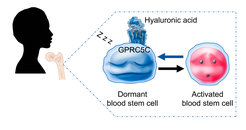The quietest stem cells are the most powerful
How hyaluronic acid protects your stem cells from proliferative stress
Hematopoietic stem cells (HSCs) are the foundation of the adult hematopoietic system and fundamental of for a constant supply of fresh cells for the blood system and a functional immune system that prevents the outbreak of infections and cancer formation. Interestingly, most HSCs remain in a very deep state of dormancy. Researchers from the MPI of Immunbiology and Epigenetics in Freiburg has now discovered a signaling pathway, the hyaluronic acid-GPRC5C signaling axis, that preserves the resting state of human hematopoietic stem cells and regulates the stem cell function.

Blood stem cells, which are known to scientists as hematopoietic stem cells (HSCs), reside mainly within the bone marrow. These unique and rare cells are key for the production of blood throughout our lifetime, especially upon proliferative stress such as viral infections or injury which trigger blood stem cells to refuel our blood system with new cells. In the absence of stress, most blood stem cells remain inactive or dormant in order to protect their unique potential of generating mature cells within our blood. The laboratory of Nina Cabezas-Wallscheid at the MPI of Immunobiology and Epigenetics in Freiburg has revealed a signaling axis that preserves this dormant state and regulates human blood stem cell function. The study by Cabezas-Wallscheid, who is also a member of the cluster of excellence CIBSS – Centre for Integrative Biological Signalling Studies at the University of Freiburg, and her collaboration partners is published in the journal Nature Cell Biology.
A rare population within humans HSCs
In the mouse hematopoietic system, HSCs are distinguished by their level of quiescence: dormant HSCs are in a deeper quiescent state and have the highest stemness properties when compared to active HSCs. However, in humans, this distinction has never been observed. Nina Cabezas-Wallscheid and her team study the human hematopoietic system to deepen our understanding of how the human body responds to stress. “Using state-of-art technologies like single-cell RNA sequencing, we were able to examine these rare HSCs at a much higher resolution. This approach allowed us to analyze hundreds of HSCs simultaneously, and we found that even within a highly purified HSC population there was still a high level of heterogeneity. We could observe that dormancy was one property that could explain some of this heterogeneity,” stated Nina Cabezas-Wallscheid.
The surface receptor named GPRC5C has previously been shown to be enriched in mouse dormant HSCs, although its function was unclear in humans. “Indeed, we found that GPRC5C enriches for human dormant HSCs, and that also plays a major role in regulating dormancy and, as a consequence, stemness” said Yu Wei Zhang, the study’s first author.
Hyaluronic acid can prevent proliferative stress
A molecule called hyaluronic acid is an important component of the bone marrow. “At the beginning of our study, it was unknown which molecule binds to GPRC5C. Using biochemical assays, we discovered that hyaluronic acid may be able to bind to GPRC5C. We also found that hyaluronic acid interacts with GPRC5C to increase quiescence and maintain its stemness during proliferative stress” stated Julian Mess, the study’s second author.
The research team of Nina Cabezas-Wallscheid uncovered the hyaluronic acid–GPRC5C signaling axis as a regulator of human HSC dormancy. “Our next step will be to understand whether this signaling axis is altered in the context of diseased hematopoiesis, such as acute myeloid leukemia,” said Nina Cabezas-Wallscheid.
NCW/MR
